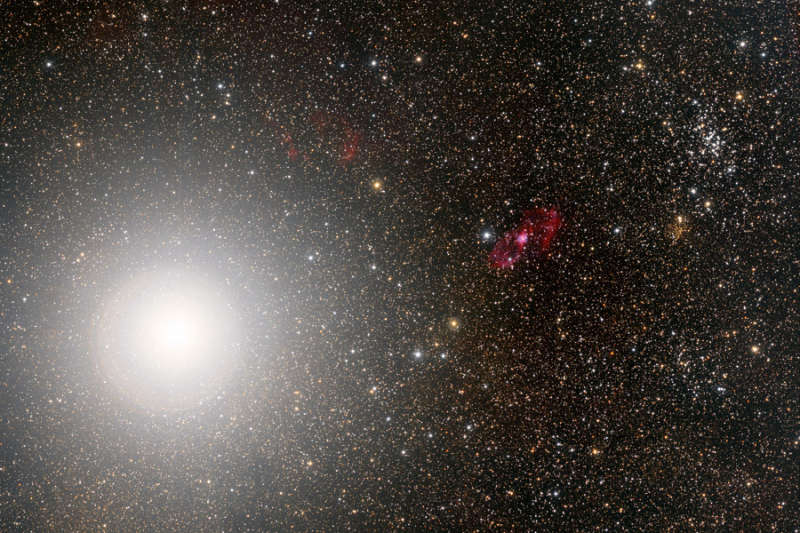
|
Credit & Copyright: Marco Lorenzi
(Glittering Lights)
Explanation:
The glare of Alpha Centauri, one of the brightest stars in planet
Earth's night sky, floods the left side of this
southern skyscape.
A mere 4.3 light-years distant,
Alpha Centauri actually consists of two
component stars similar in size to the Sun, locked in a mutual orbit.
Much smaller and cooler, a third member of the same star system, Proxima
Centauri, lies outside this field of view.
Still, the telescopic scene does reveal often overlooked denizens of the
Milky Way's crowded galactic plane that lie beyond the glare of Alpha
Centauri, including a planetary nebula
cataloged as Hen 2-111, an estimated 7,800 light-years away.
The gaseous shroud of a dying star,
the nebula's brighter core and
fainter halo of reddish ionized gas span over twenty light-years, seen
just right of picture center.
Farther right are two notable
open clusters
of stars, the
compact
Pismis 19 also nearly 8,000 light-years
away whose light
is reddened by intervening dust, and the looser, closer NGC 5617.
Just visible in the glare of Alpha Centauri is the dim glow of a shell-like
supernova remnant,
above and right of the closest star system's bright core.
|
January February March April May June July August September October November December |
| ||||||||||||||||||||||||||||||||||||||||||||||||
NASA Web Site Statements, Warnings, and Disclaimers
NASA Official: Jay Norris. Specific rights apply.
A service of: LHEA at NASA / GSFC
& Michigan Tech. U.
Based on Astronomy Picture
Of the Day
Publications with keywords: planetary nebula - supernova remnant
Publications with words: planetary nebula - supernova remnant
See also:
- APOD: 2026 January 19 Á CTB 1: The Medulla Nebula
- APOD: 2026 January 7 Á Simeis 147: The Spaghetti Nebula Supernova Remnant
- APOD: 2026 January 5 Á The Red Rectangle Nebula from Hubble
- APOD: 2024 April 30 Á GK Per: Nova and Planetary Nebula
- APOD: 2025 October 1 Á NGC 6960: The Witchs Broom Nebula
- APOD: 2025 August 31 Á NGC 7027: The Pillow Planetary Nebula
- APOD: 2025 August 22 Á A Tale of Two Nebulae
